Tiered Loyalty Programs in 2024: Benefits, Tips & Examples
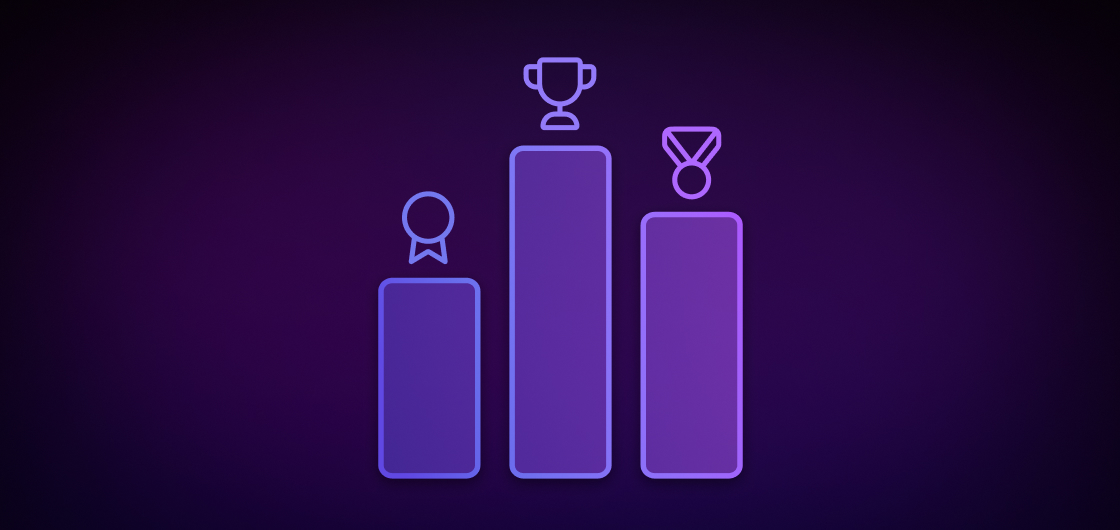
You can boost customer engagement with a tiered loyalty program by offering different levels of rewards based on customer activities and spending. This approach not only incentivizes customers with discounts, gifts, and exclusive perks but also helps your brand reduce advertising costs and increase revenue. By creating clear and attainable tiers, you make the program accessible and appealing, encouraging repeat interactions and higher lifetime value. This will set your brand apart, build trust, and drive long-term growth.
A tiered loyalty program helps brands stand out by enhancing their customer retention efforts compared to competitors. It involves establishing different loyalty levels based on customers fulfilling certain tasks, meeting purchase thresholds, or participating in specific activities.
These programs benefit both the customer and the brand. Customers receive incentives such as discounts, gifts, sweepstakes, giveaways, or other rewards, while the brand enjoys reduced advertising costs, increased loyalty, social proof, and higher revenues. This creates a partnership between the brand and the customer, thereby enhancing their relationship and improving brand trust.
This article will discuss the benefits of tiered loyalty programs, best practices for using them, as well as displaying some real examples as to how they are being effectively used by brands today.
What is a Tiered Loyalty Program?
A tiered loyalty program is similar to a traditional loyalty program but with added tiers that indicate the level of loyalty or customer engagement. Typically with a tiered loyalty program, the higher tiers require additional tasks or qualifiers and often more enticing rewards, discounts, or incentives.
A tiered loyalty program might have a very low qualifier or easy requirement for the lowest loyalty tier such as subscribing to email newsletters or creating an account. This makes the benefits of the loyalty program available to most customers and casts a wide net for making customers aware of the loyalty program.
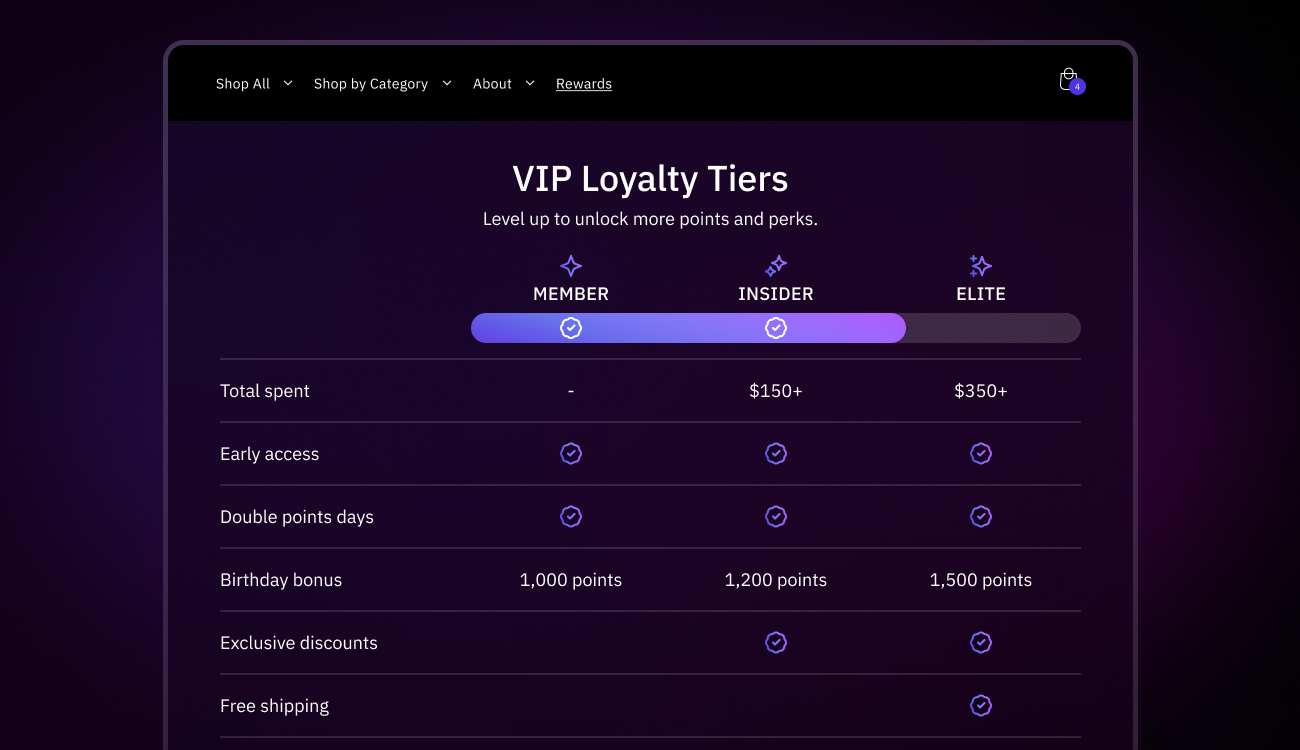
With each subsequent tier, the prerequisite tasks become more involved and the rewards become more enticing to incentivize customers to strive for a higher tier. These tasks might involve spending a certain amount or earning a number of points through interacting with the brand on social media, writing a review, or placing an order.
Why Implement a Tiered Loyalty Program?
You might consider a tiered loyalty program for your brand for a multitude of reasons. Chief among them are enhanced customer engagement, increased customer lifetime value, customer advocacy, data collection, and the ability to set your brand apart from competitors. With a tiered loyalty program, you can incentivize customers to complete different tasks that benefit your brand and create a positive customer experience.
As Alexis Priddy, CEO of YellowWebMonkey says, “Tiered loyalty programs aren’t just about discounts and rewards; they’re the monogamy of the customer relationship. They’re a commitment to keeping your customers happy, engaged, and never feeling the need to wander.”
1) Enhanced Customer Engagement
One of the main benefits of a tiered loyalty program is enhanced customer engagement. With different tiers or levels of loyalty, the customer is incentivized to have repeat and various interactions with the brand in order to meet the requirements. This increases not only the frequency of interaction but also the variety of interactions by giving the customer the opportunity to engage with different touchpoints they otherwise might not have explored.
A tiered loyalty program might require an email signup for the first tier, but then a certain purchase amount for the next tier, a product review for the third tier, and a lifetime purchase amount for the final or highest tier. These various tasks for the brand’s loyalty program guide the customer through the brand’s marketing efforts and encourage the customer to complete the desired behavior for the brand’s benefit.
2) Increased Customer Lifetime Value
With a single-tier loyalty program, customers reap all the benefits of a loyalty program by fulfilling one requirement or completing one task. Once a customer enters a loyalty program, they have very little incentive to interact with the brand further beyond the initial requirement.
A tiered loyalty program, on the other hand, ensures that customers continue to return or interact with the brand in various ways in order to reap better benefits. In this sense, customers are far more likely to have a higher lifetime value as compared to those in a single-tier loyalty program.
3) Customer Advocacy and Referrals
As customers fulfill the requirements to reach higher levels of a tiered loyalty program, they are more likely to become advocates for the brand and even refer the brand to friends or family members. Brands can also make customer advocacy a requirement or task that helps customers reach a higher loyalty tier.
A brand might incentivize customers to share referral codes or links in order to reach the next loyalty tier. Even if brands decide against making advocacy a requirement for a higher loyalty tier, customers might naturally become brand advocates after redeeming rewards through other interactions and fulfilling alternate requirements of the tiered loyalty program.
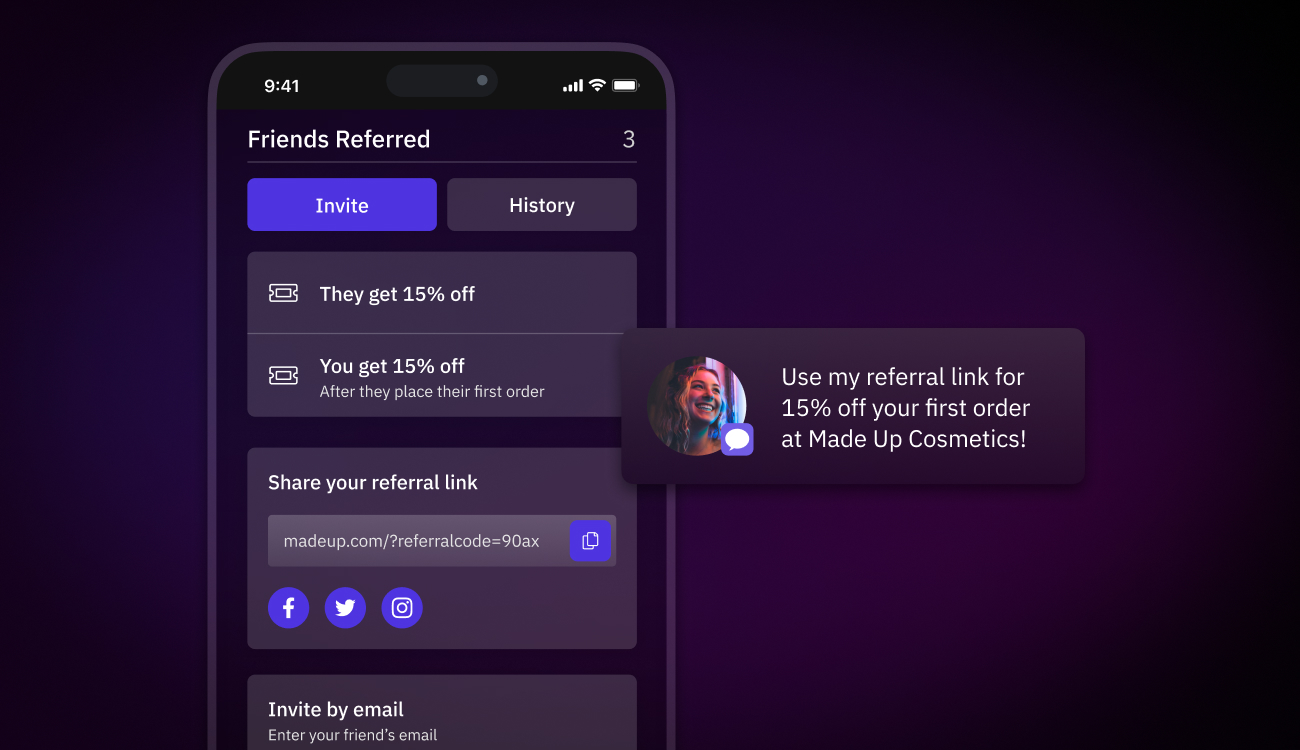
4) Data Collection and Personalization
With every interaction customers have with a brand, the brand is able to harvest first-party data and knowledge about their audience, how they shop, and their behaviors on the online store. This valuable data can help the brand improve the onsite experience and thereby increase conversion rates.
The collected data is also useful with personalization efforts. When customers return for repeat purchases, brands are much more able to identify patterns and create personalized experiences that will assist customers in their shopping journey. An effective level of personalization can only be achieved when customers return for multiple interactions with the brand which a tiered loyalty program encourages them to do.
5) Stand Out From Competitors
It seems that every brand site has some form of loyalty program or method for harvesting first-party customer data. A single-tier loyalty program might be accessible to every customer, but in that sense, it feels less special and exclusive to the customer.
A tiered loyalty program, however, helps your brand stand out from competitors by offering accessibility at the lowest tier and exclusivity at the higher tiers. Customers are incentivized to build loyalty with the brand in order to reach the higher tiers and make the most of your brand’s rewards or benefits that come with the loyalty program.
Key Features of a Successful Tiered Loyalty Program
An effective tiered loyalty program includes certain elements that contribute to its continued success. Tiered loyalty programs that are most successful often feature clear and attainable tiers, valuable rewards and benefits, and some degree of flexibility or customization. A tiered loyalty program without these features is unlikely to incentivize customers and will be ineffective in achieving the brand’s long-term growth strategy.
1) Clear and Attainable Tiers
One of the most important elements of a tiered loyalty program is the breakout of tiers and how the customer can reach them. The requirements to reach each level of loyalty should be clearly explained and attainable otherwise they could create the opposite of the desired effect and dissuade customers from engaging with the brand.
Tiers that have impossible standards or require customers to jump through hoops could come across as presumptuous or demanding on the brand’s part and deter customers from joining the loyalty program altogether.
To create clear and attainable tiers, keep the requirements simple with a spending threshold, or simple tasks for earning points. Ensure that the first tier is accessible to all and gradually builds up to higher tiers with small and achievable increments that build upon the behavior of the first tier.
2) Valuable Rewards and Benefits
In order for the loyalty program to be mutually beneficial for both your brand and the customer, the rewards or benefits must be appealing, otherwise the customer will not feel incentivized to reach higher tiers. The obvious and most common reward to offer customers in a tiered loyalty program is a discount toward their next purchase with the depth of discount increasing in each tier. This is a straightforward and simple offering that is both valuable and beneficial for both the brand and the customer.
Alternative rewards or benefits include early access to highly anticipated sales events or collection launches. Early access is especially beneficial if your brand has limited stock with a high turn rate because customers would be the first to get ahold of the product before it sells out and the brand would not need to erode margins in order to offer a valuable benefit to their most loyal customers.
3) Flexibility and Customization
Offering customers customizations or flexibility in a tiered loyalty program is a way that your brand can set itself apart from the competition. A straightforward way to offer flexibility is by offering discounts on any and all products or services available.
Since brands typically run sales events on only a select number of products, this creates the added benefit of loyalty members being able to receive discounts on even coupon or sale-excluded products. Brands can also offer flexibility in the way customers earn points. Instead of just giving points to customers for spending, points can be rewarded for engaging with social media accounts, referring a friend, or reviewing a product.
3 Powerful Tiered Loyalty Program Examples
These brands have leveraged Okendo Loyalty to create personalized and unique tiered loyalty programs that significantly enhance customer engagement and retention.
1) Jordan Craig’s Loyalty Program
Jordan Craig, a prominent streetwear brand, offers a cutting-edge loyalty program designed to resonate with its unique customer base. Featuring three tiers—Pros, Stars, and Legends—the program rewards its most dedicated customers with ‘clout’ instead of traditional points.
Legends, the brand’s Superfans, enjoy exclusive benefits like early access to new collections, special discounts, and personalized communications through Klaviyo. This segmentation allows Jordan Craig to connect with their highly engaged customers, enhancing their shopping experience and cultivating long-term brand loyalty. The program has delivered a remarkable 59x ROI, a 12.23% increase in average order value (AOV), and a 4% uplift in loyalty program engagement.
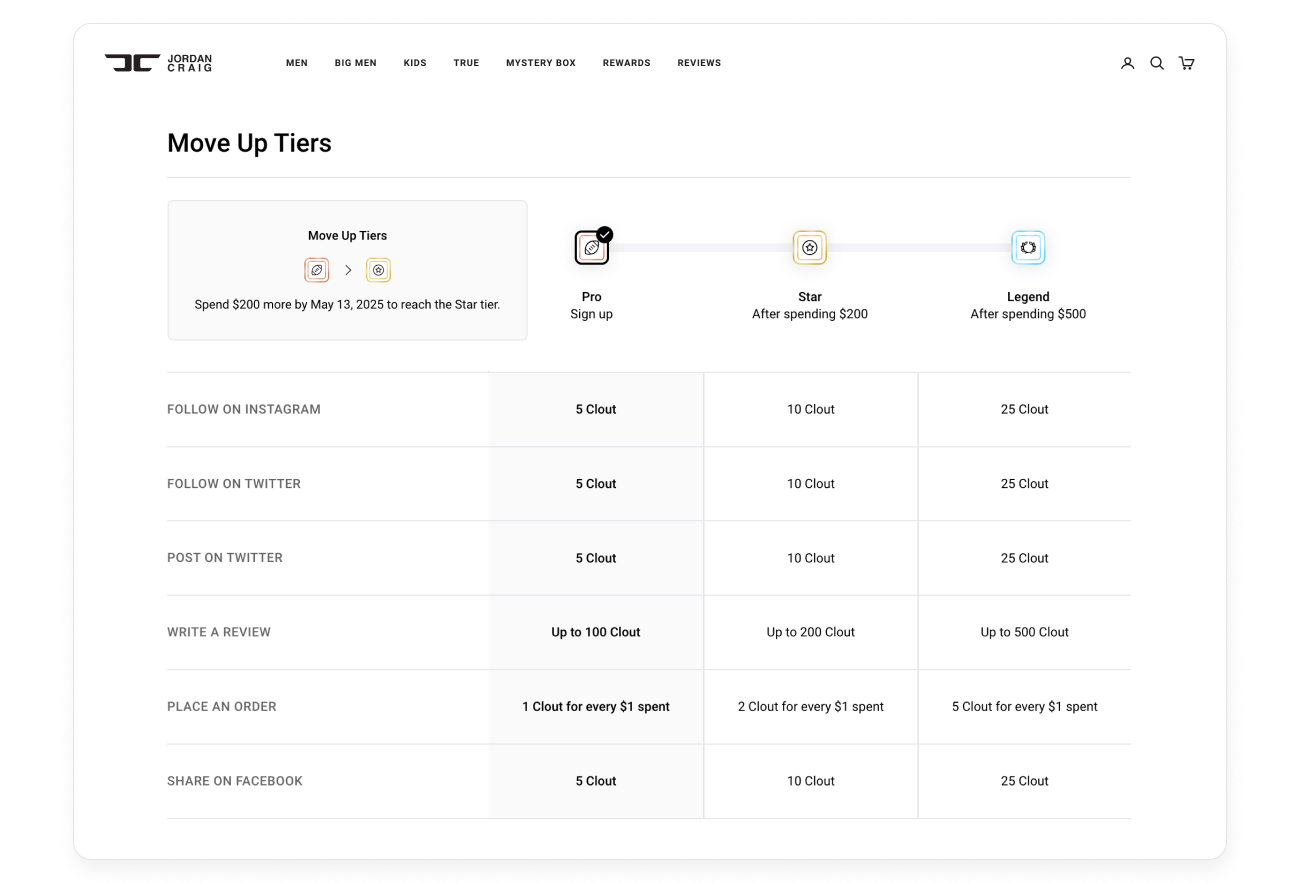
2) Veselka’s Rainbow Rewards Program
Veselka, a popular restaurant, has implemented the Rainbow Rewards program, which offers customers “Pierogi Points” for purchases and activities. As customers accumulate points, they move up tiers, unlocking perks like discounts on meals. This program encourages frequent visits and builds a strong community of loyal customers.
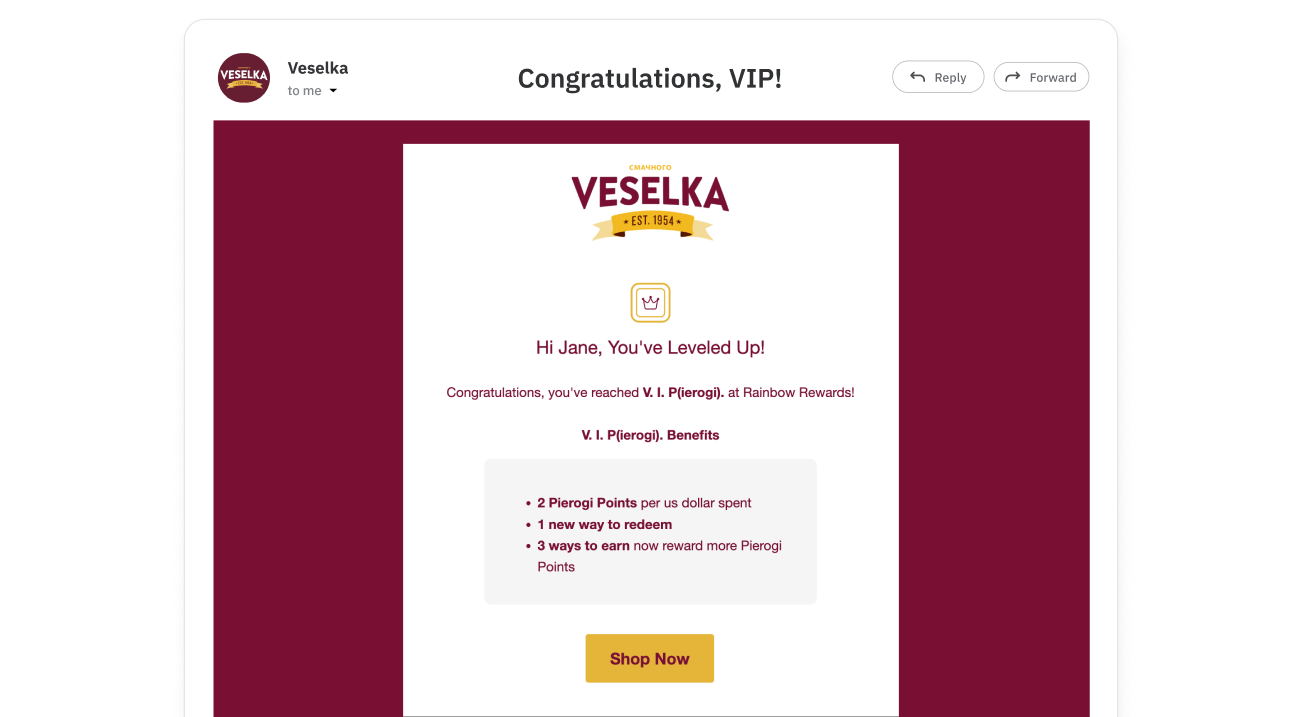
3) Dixxon’s DILF Program
Dixxon, a clothing company specializing in “flannels that don’t suck,” created the tiered Dixxon Insider Loyalty Fam (DILF) program to reward their customers. DILF members earn points for every purchase to progress up the four tiers: Amateur, Pro, Legend, and Hall of Fame. The points required to ascend, as well as the corresponding customized perks, are clearly outlined on the brand’s website.
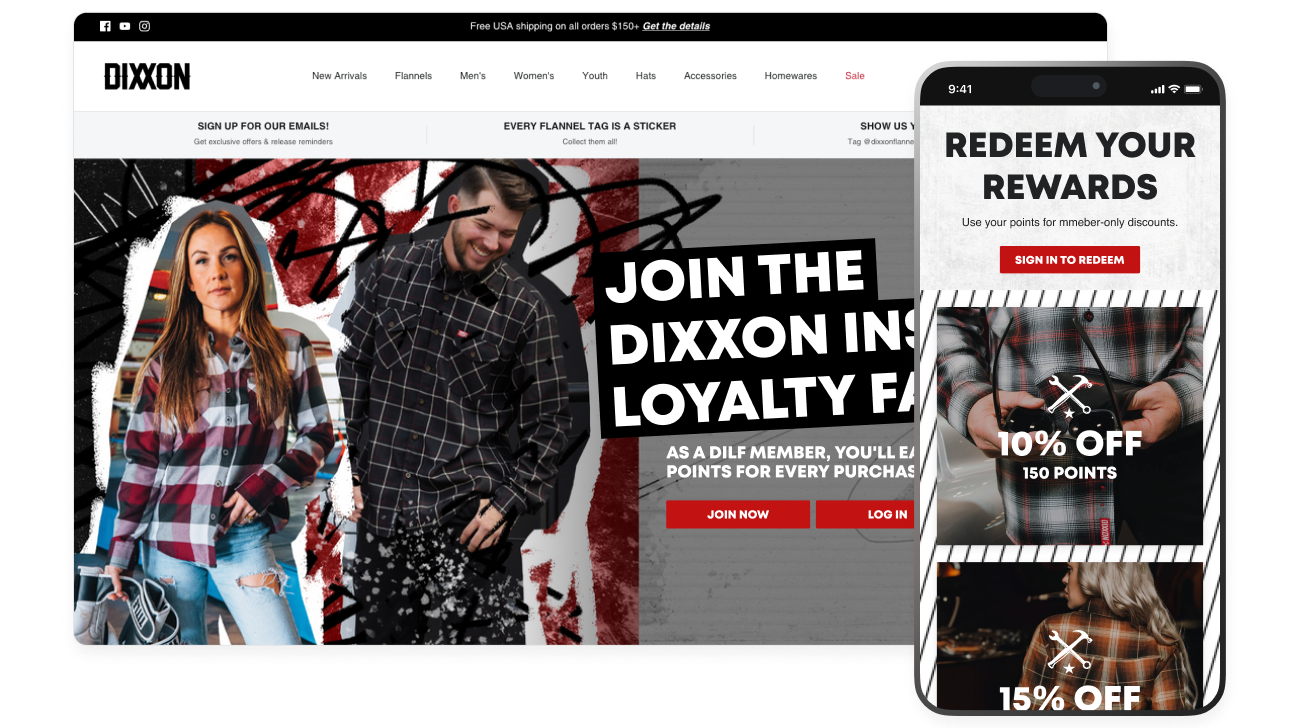
How to Create a Tiered Loyalty Program: Step-by-Step
Okendo can help your brand create an effective tiered loyalty program and track your customers’ loyalty status, available rewards, and completed requirements.
Step 1: Map Out Your Tiers
The first step to creating your tiered loyalty program with Okendo is to map out your tiers and decide on the requirements or thresholds for each loyalty level. Okendo has the functionality for unlimited tiers, but we typically recommend between 3 and 5 to keep the program clear and attainable (as mentioned above).
Step 2: Create a Base Tier
By default, Okendo will create a base tier for all loyalty programs. Customers will automatically be in the base tier when they enroll in the loyalty program.
Step 3: Add Additional Tiers
To create additional tiers, click the ‘+’ on the VIP Tiers screen and begin inputting the spend requirement limits, earn points, and redeem rewards for that tier.
Step 4: Specify Actions for Earning Points
In the additional tiers screen, you can specify what actions such as placing an order, writing a review, or following social media accounts earn points toward rewards. You can also modify the rewards afforded after moving up tiers.
Step 5: Customize Perks
The custom perks section allows for ultimate flexibility with an open field for tracking additional perks like exclusive access to in-store events, early access to sales events, or specialized customer services.
Step 6: Track Spending and Assign Tiers
Once launched, Okendo will track your enrolled members’ spending and assign tiers based on spending thresholds. Tiering is based on a 12-month rolling timeframe, not on points earned. Points are used solely for redeeming rewards or discounts.
For example, if a VIP tier requires a $500 spend, customers who place a $300 order in January and a $200 order in March will have VIP status until 12 months after the March order which qualifies them for a higher tier. When the 12-month timeframe expires, the customer must place an additional order to reach the $500 minimum spend and maintain the VIP status.
Conclusion
Adopting a tiered loyalty program benefits not just customers but also your brand’s reputation, retention, revenue, and long-term viability. It incentivizes higher spending and loyalty, creating brand advocates who drive virality. Unlike standard discount-based rewards, a tiered program allows for creative benefits, such as exclusive access and special services, enhancing reputation while preserving profitability.
Successful programs are simple, clear, attainable, and offer valuable rewards, engaging customers at various touchpoints. To implement an effective tiered loyalty program and enjoy these mutual benefits, book a demo with Okendo for a comprehensive consultation.
FAQs
Why are tiered loyalty programs so attractive to customers?
Tiered loyalty programs are attractive to customers because they allow for greater rewards for greater interactions with the brand. They incentivize certain behaviors to achieve the next tier or level which in a way gamifies the shopping experience. Customers might also view the higher loyalty tiers as a status symbol or exclusive membership and potentially create brand advocates who take pride in their VIP status with the brand.
What are the benefits of tiered membership?
As mentioned, a tiered membership is mutually beneficial for both the brand and the customer. For the customer, a higher tier of membership offers greater discounts or rewards plus added perks like exclusive access to store events or anticipated sales. For the brand, tiers incentivize customers to show loyalty in different ways or increase their spending so that the brand can appeal to additional customers and ultimately increase revenues.
Are tiered loyalty programs more effective?
Yes, tiered loyalty programs are more effective in keeping customers consistently and continuously engaged, increasing customer lifetime value, and ultimately impacting the brand’s growth. A single-tier loyalty program is generally better than no loyalty program, but a tiered program would help brands stand out from the crowd and reward customers based on the brand’s unique loyalty program strategy.